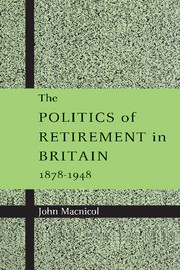Book contents
- Frontmatter
- Contents
- List of tables
- Acknowledgements
- Part I The campaign for old age pensions
- Part II Contributory pensions
- Part III The debate on retirement pensions
- Part IV The ‘Beveridge revolution’
- 13 The pensions crisis of the late 1930s
- 14 The Treasury enquiry and the 1940 Act
- 15 The origins and working of the Beveridge Committee
- 16 After the Beveridge Report, 1942–1948
- 17 Conclusion
- Index
13 - The pensions crisis of the late 1930s
Published online by Cambridge University Press: 01 October 2009
- Frontmatter
- Contents
- List of tables
- Acknowledgements
- Part I The campaign for old age pensions
- Part II Contributory pensions
- Part III The debate on retirement pensions
- Part IV The ‘Beveridge revolution’
- 13 The pensions crisis of the late 1930s
- 14 The Treasury enquiry and the 1940 Act
- 15 The origins and working of the Beveridge Committee
- 16 After the Beveridge Report, 1942–1948
- 17 Conclusion
- Index
Summary
During the Second World War, Britain's income-maintenance policies were substantially reorganised. The central episode in this process of reorganisation was, of course, the publication of the Beveridge Report of 1942. At the time – to a war-weary public desperate for good news – the Beveridge Report seemed to promise radical changes. And, from a short-term perspective, the ‘Beveridge revolution’ did indeed appear remarkable. Within a mere three years, the stifling, restrictive attitude of the National government to any advances in social policy that might require additional public spending had given way to what appeared an exciting, even reckless expansionism. The 1930s had been dominated by the deflationary, ‘safety first’ policy of fiscal caution, with public expenditure kept low in order to free up capital for investment in the new areas of economic growth. Whatever the rights and wrongs of this policy, its benefits could only come to fruition with agonising slowness. But suddenly, with the fall of the Chamberlain government in May 1940, a new political consensus swept into power; it promised an alternative to the dismal, pre-war recipe that twentieth-century British capitalism could only move from slump to boom at a cautious, incremental pace, maintaining a large reserve army of unemployed labour.
The social policy arm of this political and economic New Jerusalem was the Beveridge Report. In Beveridge's brave new welfare state, social security was to be universal in cover, comprehensive in provision and – through the ‘subsistence principle’ – adequate in amount to deliver the long-standing radical dream of a ‘national minimum’.
- Type
- Chapter
- Information
- The Politics of Retirement in Britain, 1878–1948 , pp. 287 - 324Publisher: Cambridge University PressPrint publication year: 1998



